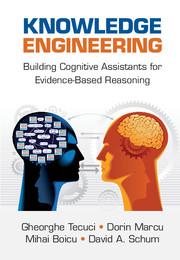Book contents
- Frontmatter
- Contents
- Preface
- Acknowledgments
- About the Authors
- 1 Introduction
- 2 Evidence-based Reasoning: Connecting the Dots
- 3 Methodologies and Tools for Agent Design and Development
- 4 Modeling the Problem-Solving Process
- 5 Ontologies
- 6 Ontology Design and Development
- 7 Reasoning with Ontologies and Rules
- 8 Learning for Knowledge-based Agents
- 9 Rule Learning
- 10 Rule Refinement
- 11 Abstraction of Reasoning
- 12 Disciple Agents
- 13 Design Principles for Cognitive Assistants
- References
- Appendixes
- Index
Appendixes
Published online by Cambridge University Press: 05 September 2016
- Frontmatter
- Contents
- Preface
- Acknowledgments
- About the Authors
- 1 Introduction
- 2 Evidence-based Reasoning: Connecting the Dots
- 3 Methodologies and Tools for Agent Design and Development
- 4 Modeling the Problem-Solving Process
- 5 Ontologies
- 6 Ontology Design and Development
- 7 Reasoning with Ontologies and Rules
- 8 Learning for Knowledge-based Agents
- 9 Rule Learning
- 10 Rule Refinement
- 11 Abstraction of Reasoning
- 12 Disciple Agents
- 13 Design Principles for Cognitive Assistants
- References
- Appendixes
- Index
Summary
SUMMARY: KNOWLEDGE ENGINEERING GUIDELINES
Knowledge Base Guidelines
Guideline 3.1. Work with only one knowledge base loaded in memory (p. 111)
Guideline 3.2. Create a knowledge base and save successive versions (p. 111)
Modeling Guidelines
Guideline 4.1. Structure the modeling process based on the agent's specification (p. 147)
Guideline 4.2. Define reduction trees in natural language using simple questions (p. 148)
Guideline 4.3. Identify the specific instances, the generic instances, and the constants (p. 148)
Guideline 4.4. Guide the reduction by the possible need of future changes (p. 149)
Guideline 4.5. Learn and reuse reduction patterns (p. 149)
Ontology Development Guidelines
Guideline 6.1. Define similar siblings (p. 186)
Guideline 6.2. Group similar siblings under natural concepts (p. 187)
Guideline 6.3. Recognize that a single subconcept may indicate ontology incompleteness or error (p. 187)
Guideline 6.4. Adopt and follow a naming convention (p. 188)
Guideline 6.5. Name subconcepts based on superconcepts (p. 189)
Guideline 6.6. Represent well-established categories fromthe real world as concepts (p. 195)
Guideline 6.7. Define concepts and instances to represent knowledge corresponding to n-ary relations (p. 196)
Guideline 6.8. Define feature names that distinguish them from concept names (p. 196)
Guidelines for Rule and Hypothesis Learning
Guideline 9.1. Properly identify all the entities in the example before starting rule learning (p. 285)
Guideline 9.2. Avoid learning from examples that are too specific (p. 286)
Guideline 9.3. Use modeling-based ontology extension before starting rule learning (p. 286)
Guideline 9.4. Carefully define the domains and the ranges of the features (p. 286)
Guideline 9.5. Provide hints to guide explanation generation (p. 288)
Guideline 9.6. Avoid learning rules without explanations (p. 288)
Guideline 9.7. Recognize concepts in the reasoning tree (p. 288)
Guidelines for Rule Refinement
Guideline 10.1. Assess similar hypotheses to refine the rules (p. 321)
Guideline 10.2. Extend the ontology to define failure explanations (p. 321)
Abstraction Guideline
Guideline 11.1. Define short context-dependent hypothesis names for the abstract tree (p. 334)
Planning Guidelines
Guideline 12.1. Use a plausible task ordering when specifying a task decomposition (p. 398)
Guideline 12.2. Specify the planning tree in a top-down and left-to-right order (p. 399)
Guideline 12.3. Define preconditions when reducing an abstract task to a concrete task (p. 399)
Guideline 12.4. Specify the goal of the current task to enable the specification of the follow-on tasks (p. 400)
- Type
- Chapter
- Information
- Knowledge EngineeringBuilding Cognitive Assistants for Evidence-based Reasoning, pp. 443 - 446Publisher: Cambridge University PressPrint publication year: 2016



